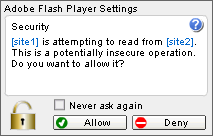Flash Player Help
Table of Contents
Security pop-up question
- Why do I need to answer this question?
- What happens if I select Allow?
- What happens if I select Deny?
- What happens if I select Never Ask Again?
- Do I have to answer this question every time I view SWF or FLV content on a website?
- How can I display this question again?
- I am a site developer. How can I prevent users from seeing this question?

Why do I need to answer this question?
This question appears because the application currently running in Adobe Flash Player is trying to access information from a site outside its own domain, using an older system of security. Flash Player is alerting you that information might be shared between two sites and is asking if you want to allow or deny such access. In the question shown above, [site1] represents the name of the person or company who created the application that is trying to access another site, represented by [site2].
The site being accessed, [site2], determines which other sites can access it. In some cases, that person or company might not have indicated which other sites are allowed access. Therefore, Flash Player alerts you before it tries to access [site2]. If you see this question and are concerned, you can contact the person or company being accessed and notify them that you are seeing this question.
Note that it is the person or company that has created the application you are using that is requesting such access, not Adobe (unless Adobe has created the application that wants access to the other site). It's important to understand that even though this pop-up question is part of Adobe Flash Player, an application created by a third party is requesting access to another site. Adobe assumes no responsibility for third-party privacy policies, actions of third-party companies in accessing sites outside of their domain, or such companies' use of such data or information.
What happens if I select Allow?
If you select Allow, the application is granted access to the other site and continues to access it until you close the application. It is possible that the application could access unauthorized information from [site2], though this is unlikely. There are two things you can look for before selecting Allow:
- Do you recognize and trust the person or company ([site1]) that is trying to access the other site? For example, if [site1] is a well-known website that you use frequently and trust, it is probably safe to allow access.
- Do [site1] and [site2] belong to the same domain? For example, if server1.adobe.com is trying to access server2.adobe.com, you can see that both server1 and server2 are part of the Adobe.com domain, and it is probably safe to allow access.
It is the responsibility of the person or company whose site is being accessed to determine which other sites can access their site. If you select Allow but still have questions, you might want to contact the person or company being accessed and notify them that you are seeing this question.
What happens if I select Deny?
If you select Deny, the application is prevented from accessing the other site. The application continues running, but it may not function as intended. If you do not recognize or trust [site1], the person or company trying to access the other site, it is probably safer to deny access. It is possible that [site1] could obtain unauthorized information from [site2].
What happens if I select Never Ask Again?
If you select Never Ask Again, your selection of Allow or Deny is remembered in the Settings Manager in the Global Security Settings panel, and you won't see the security pop-up question again:
- If you select Never Ask Again and Allow, websites that use the older security system and try to access another site will always be granted access, without asking your permission.
- If you select Never Ask Again and Deny, websites that use the older security system and try to access another site will always be denied access, and SWF or FLV content or applications from these websites might not function as intended.
Do I have to answer this question every time I view SWF or FLV content on a website?
You should not have to answer this question frequently. If you see this question frequently, contact the person or company whose site is being accessed and notify them that you are seeing this question. The person or company can then address this issue. If you select Never Ask Again, you will not have to answer this question again (see What happens if I select Never Ask Again?). If you select Never Ask Again but later change your mind, you can change your security settings in the Global Security Settings panel.
How can I display this question again?
If you select Always Ask My Permission in the Global Security Settings panel in the Settings Manager, you'll see this question each time a website using the older system of security tries to access another site.
I am a site developer. How can I prevent users from seeing this question?
To prevent users from seeing this question, you need to specify in a policy file which websites are allowed to access your site. For more information about policy files and exact domain matching, see the Adobe Flash Player security website.